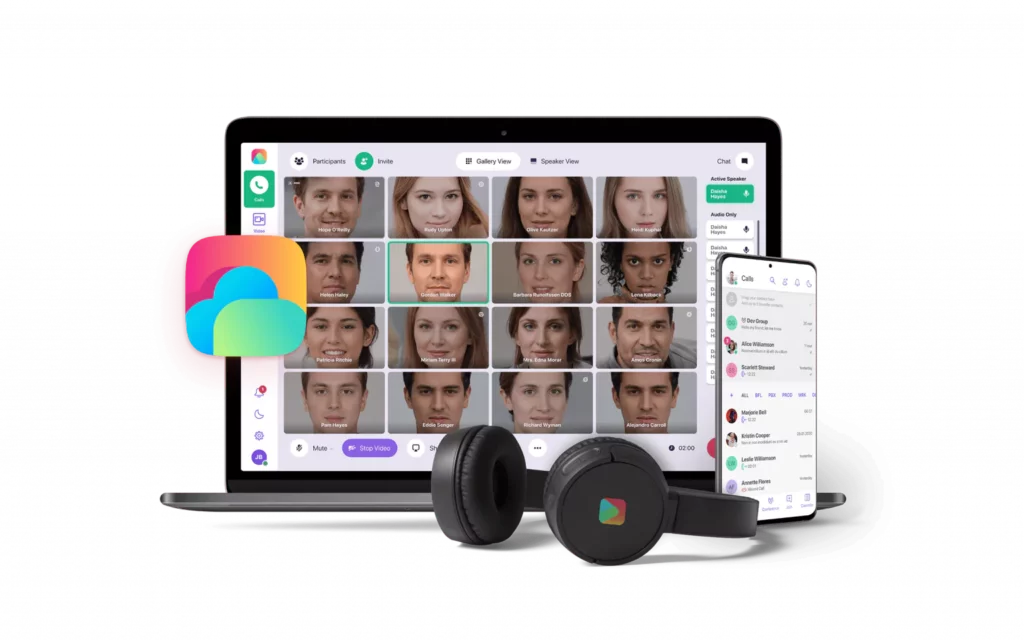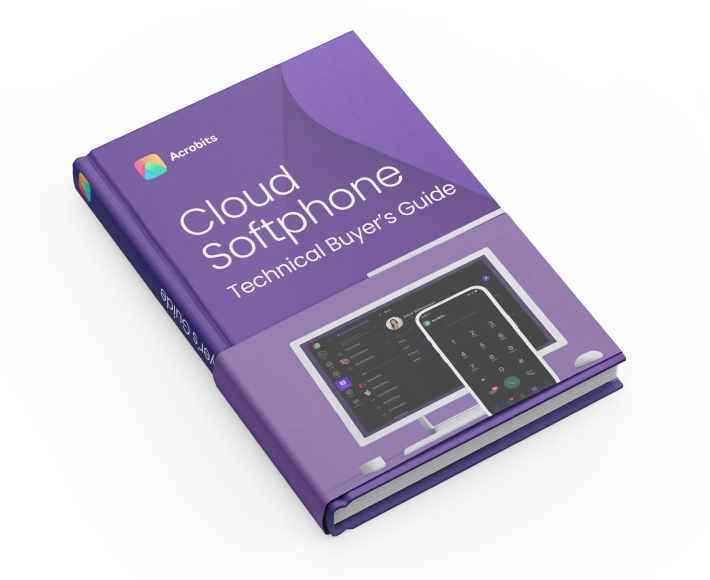A multi-channel communication platform begins with a telephony system that operates through software and offers Internet-based calling capabilities. Compared to traditional telephones, they do not use copper wiring and do not connect directly to the public switched telephone network (PSTN).
From there, Internet-based communications allow for true multi-channel communication. Your organization will be ready to make voice and video calls, send instant messages, and manage your contacts on multiple devices, including computers, smartphones, and tablets.
This type of communication solution offers the convenience and flexibility of being able to work from anywhere, on any device, with a consistent user experience.
The software-based nature of these platforms gives them a significant edge over other types of communication tools, especially for businesses.
- Convenience. Like most modern software programs, multi-channel communication platforms can run on your existing computers and mobile devices. There’s no need for specialized hardware, which reduces the cost of implementation and allows your staff to use the devices they’re already familiar with.
- Mobility. In the age of remote work, there’s been an emphasis on maintaining a mobile workforce. Traveling professionals and even in-office employees benefit from having a line of communication with the company no matter where they are. These leading-edge platforms allow them to do so, enabling access to communication even when away from the desk.
- Security and privacy. Management teams are sometimes wary of cloud tools because of cyber security threats and privacy concerns. Providers of multi-channel communication solutions respond with security features that keep sensitive information intact as it travels through the network. Employees likewise can run the applications on their personal devices without mixing personal and work-related communications.
- Feature set. Another significant advantage of multi-channel platforms over traditional telephones is the potential for more features. Almost all business-grade offerings have video conferencing, call recording and transfers, visual voicemail, employee availability and status, and notification support.
Under today’s competitive market conditions, there’s no reason for businesses in any industry to delay their adoption of this powerful, new technology. The only question now is what service to use.

Organizations across various industries can benefit from a multi-channel communication platform. These platforms are especially advantageous for businesses that require robust and flexible communication methods. Key beneficiaries include:
- Remote and Hybrid Workforces: Companies with employees working remotely or in hybrid environments can use these platforms to maintain seamless communication regardless of location.
- Customer Service Centers: Multi-channel platforms enable customer service teams to interact with clients through various channels like voice, video, SMS, and email, enhancing customer engagement and support.
- Sales and Marketing Teams: These teams can leverage multi-channel platforms for efficient outreach and follow-ups, using diverse communication methods to connect with prospects and clients.
- IT and Tech Companies: These organizations can use multi-channel platforms for internal team collaboration and external client communication, benefiting from features like video conferencing and group messaging.
- Healthcare Providers: For telemedicine and patient communication, these platforms offer secure and varied communication channels.
- Education Institutions: Schools and universities can use these platforms for virtual classrooms, staff meetings, and parent-teacher communications.
- Global Enterprises: Large organizations with international operations can benefit from the platform’s ability to facilitate cross-border communication and collaboration.
- Startups and Small Businesses: These businesses can use multi-channel platforms to establish a professional communication system without the need for extensive infrastructure.
Multi-channel implies that the application can run on various devices and operating systems while also enabling multiple methods. Windows and Linux are typical examples of desktop operating environments, while iOS and Android cover most of the mobile device sector.
There are many reasons to choose an Internet-based multi-channel communication platform for your organization:
- Accessibility: Compatibility with more device types and operating environments makes the application more accessible to all types of users in your business. For instance, on-site staff can communicate through their desktop workstations with remote employees on their mobile devices.
- Ease of deployment: As long as your multi-channel communication service provider is multi-platform, you don’t have to put in any work yourself to get the application running on all your devices. Deployment time is much smoother and faster as a result, minimizing the chance of delays that can cause disruptions in productivity.
- Scalability. Built-in cross-platform support likewise makes expanding operations easier. You can guarantee that any new devices you introduce into your network are compatible with your current platform.
- Consistency. The user interface, user experience, and general performance of the app stay the same on all devices since it runs natively on each one. This uniformity makes it easier for different employees to work together, even if everyone uses a different device. Additionally, tying multiple channels of communication into the same platform provides a consistent experience for employees, customers, and partners.
- Maintenance. Because the code base is essentially the same across all variations of the application, updates are much faster to deploy as well. Keep everybody on the same page with a cross-platform, multi-channel communication solution.
While multi-channel platforms are the future of business communication, not all of them are equal. To maximize the value you get from your new platform, you want to choose one with cross-platform compatibility.
Many multi-channel platforms tailored to businesses also offer white-labeling, where the client organization purchases the application but brands it as their own.

Having your business’s logo and name on the tools you use everyday boosts brand recognition. However, building an entire communication platform yourself from scratch is far too expensive and time-consuming.
White-labeling brings you the best of both worlds. You retain the benefits of personal branding yet also outsource the heavy lifting to a specialized service provider, which can give you the features you want at a much lower upfront cost.
The right moment to switch to a multi-channel communication platform is when your business needs to enhance collaboration and customer engagement.
This typically aligns with growth phases, increasing remote work, or when current communication methods no longer meet efficiency and scalability needs. Adopting such a platform becomes essential when diverse communication channels (like voice, video, SMS, and email) are needed to streamline internal collaboration and improve customer interactions.
This transition is crucial for businesses aiming to stay competitive and adapt to modern communication trends and technologies.
Where Does Multi-Channel Communication Make the Most Impact?
Wondering where Multi-Channel Communication platforms shine? Here are some ideal environments and industries:
Remote Work Environments:
Enhances collaboration and connectivity among geographically dispersed teams.
Customer Service Centers:
Offers diverse channels (voice, video, SMS) for comprehensive customer support.
Healthcare Settings:
Facilitates telemedicine and efficient patient-provider communication.
Retail Industry:
Aids in multi-faceted customer engagement and support across various platforms.
Educational Institutions:
Supports virtual learning and seamless staff-student-parent interactions.
Global Corporations:
Enables efficient cross-border collaborations and meetings.
Startups and SMEs:
Provides scalable, cost-effective communication solutions without extensive infrastructure.
Choosing the best system is challenging, thanks to the high demand for multi-channel communication technology in the business sector.
While some are excellent in many use cases, your choice boils down to your specific needs and expectations. What works for one organization might not be ideal for another. So here are some of the most well-known options to get your search started.
Acrobits Cloud Softphone
Acrobits is one of the earliest and most experienced service providers in the industry. On top of extensive white-labeling, video conferencing, and other heavily sought-after features, its Cloud Softphone prides itself on exceptional cross-platform functionality.

Users can transition from use on a mobile device to a desktop seamlessly. Compatibility ranges from mobile devices running Android or iOS to desktop environments with Windows or macOS, spanning over 24,000 different device models.
Bria
While this long-running service provider has a free version of its application known as Bria Solo, its main claim to fame is its business-focused offering, Bria Teams. It offers compatibility with various operating environments and an extensive feature set.
Grasshopper
Grasshopper’s main website appeals mainly to small business owners, touting ease of use and affordable pricing structures for those starting off with VoIP-based technology. Its cross-platform compatibility likewise extends to Windows, macOS, Android, and iOS.
The company even offers number portability so that users can continue to use their existing phone numbers with their new systems. However, the lack of video conferencing is definitely worth considering when making your decision.
Zoiper
Another platform with support for Android, iOS, and desktop operating systems is Zoiper, which targets both residential and commercial clients and offers multiple communication channels. All the essential features are here, like white-labeling and push notifications. Zoiper is also well-known for its user-friendly interface.
How Can I Connect My Entire Workforce with Multi-Channel Communication Technology from Acrobits?
It’s time for a device and location-agnostic communication platform for your business. A cross multi-channel communication platform is the silver bullet for creating a connected experience in the workplace.
Whether employees work at their desks or connect with the office abroad from their personal devices, multi-channel solutions put everybody on the same page.
Employees are able to communicate however best suits their needs and preferences, while customers and partners can reach out via text, voice calls, or video chats.
The best way to implement a cross-platform, multi-channel communication platform into your workflow as soon as possible is through Acrobits Cloud Softphone. We provide not only an entire toolkit to get you up and running with all the features you’ll need but also:
- All-encompassing cross-platform compatibility. It doesn’t matter if your employees prefer Windows, macOS, Android, iOS, or any combination of operating environments because Cloud Softphone seamlessly works on all of them. Users can join a meeting with a single click on any web browser, resulting in unparalleled convenience and flexibility.
- Top-of-the-line network capabilities. Our LinkUp white label video conferencing solution works for anything from one-on-one conversations to full conference rooms with 15 simultaneous video feeds or 24 audio callers. Physical distance is no longer a barrier to effective collaboration at your organization.
- White labeling. Don’t settle for a generic, one-size-fits-all app that everyone else uses. Stand out in the crowd with Cloud Softphone, which allows you to brand the application for a truly personalized experience becoming one of the most popular white label communication platforms around. Apply your own logos, colors, and UI elements to spice up your sales demos and conferences.
The future of communications is happening on all devices at all times. There’s no getting around that. Companies looking to stay competitive must create flexible experiences that allow end users to connect and collaborate using mobile and desktop devices.
Are you looking to create a cross-platform communications experience? Then, a branded multi-channel platform like Cloud Softphone can help. See why major brands like Digium, Metaswitch, BroadSoft, and PortaOne trust us with their communications.
Want to see what a softphone can do to empower your teams? Book a demo today to get started.










